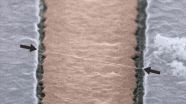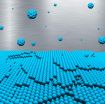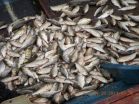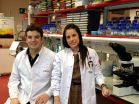Longhorn beetle inspires ink to fight counterfeiting
2014-11-05
(Press-News.org) From water marks to colored threads, governments are constantly adding new features to paper money to stay one step ahead of counterfeiters. Now a longhorn beetle has inspired yet another way to foil cash fraud, as well as to produce colorful, changing billboards and art displays. In the journal ACS Nano, researchers report a new kind of ink that mimics the beetle's color-shifting ability in a way that would be long-lasting and difficult to copy.
Zhongze Gu, Zhuoying Xie, Chunwei Yuan and colleagues explain that some U.S. bills have color-changing features to help thwart attempts by counterfeiters to make fake money. But these features based on the chemical structural changes of dyes, pigments or polymers tend to fade when exposed to light and air. Researchers have been developing a new set of color-changing materials known as colloidal photonic crystals that are bleach resistant. The methods that use these crystals remain expensive, however. Inkjet printing is a fast, precise and low-cost alternative, but until now, researchers had not developed the right inks for making such color-changing and complex patterns. For inspiration, Gu's team turned to Tmesisternus isabellae, a longhorn beetle that can shift from gold to red and back again, depending on the humidity.
The researchers designed an ink that they can finely tune to change color, for example, from bright green to yellow or red when exposed to ethanol vapors. It can also return to its original color. The ink is also durable, resistant to bleaching when exposed to light and can be applied to hard or flexible surfaces.
INFORMATION:
The authors acknowledge funding from the National Natural Science Foundation of China, the Program for Changjiang Scholars and Innovative Research Team in University, Qing Lan Project, 333 Talent Project Foundation of Jiangsu Province and the Science and Technology Development Program of Suzhou.
The American Chemical Society is a nonprofit organization chartered by the U.S. Congress. With more than 161,000 members, ACS is the world's largest scientific society and a global leader in providing access to chemistry-related research through its multiple databases, peer-reviewed journals and scientific conferences. Its main offices are in Washington, D.C., and Columbus, Ohio.
To automatically receive news releases from the American Chemical Society, contact newsroom@acs.org.
Follow us: Twitter Facebook
ELSE PRESS RELEASES FROM THIS DATE:
2014-11-05
Researchers from MIPT and the Weizmann Institute of Science (Israel) have predicted the possibility of negative turbophoresis, a phenomenon where impurity particles inside a turbulent flow move in an "impossible" direction. The study by Sergei Belan (a postgraduate at MIPT), Grigory Falkovich and Itzhak Fouxon was published in the journal Physical Review Letters in the Editors' Suggestions section, which features the most important and interesting studies from the editorial board's point of view.
The researchers studied the behavior of inertial particles in different ...
2014-11-05
An international study has devised a new measure for the "livability" of major cities across the world. The Global Liveable Cities Index (GLCI) takes into account the sensibilities of ordinary working people from 64 cities, balancing work and play, environmental awareness, localism, globalism and many other factors. Details are published in the World Review of Science, Technology and Sustainable Development.
According to Tan Khee Giap of the National University of Singapore and colleagues at University of California, Davis, and Curtin University, in Bentley, Australia, ...
2014-11-05
In a recent paper published in Nature Nanotechnology, Joel Moser and ICFO colleagues of the NanoOptoMechanics research group led by Prof. Adrian Bachtold, together with Marc Dykman (Michigan University), report on an experiment in which a carbon nanotube mechanical resonator exhibits quality factors of up to 5 million, 30 times better than the best quality factors measured in nanotubes to date.
Imagine that the host of a dinner party tries to get his guests' attention by giving a single tap of his oyster spoon on his crystal glass. Now, imagine, to the amazement of all, ...
2014-11-05
New Danish-led research suggests that signs of brain aging can be postponed in mice if placed on a high-fat diet. In the long term, this opens the possibility of treatment of children suffering from premature aging and patients with Alzheimer's and Parkinson's disease. The research project is headed by the Center for Healthy Aging, University of Copenhagen and the National Institute of Health.
When we get older, defects begin to develop in our nervous system, our brain loses some of its intellectual capacity, and the risk of developing diseases such as Parkinson's and ...
2014-11-05
Using DESY's ultrabright X-ray source PETRA III, researchers have observed in real-time how football-shaped carbon molecules arrange themselves into ultra-smooth layers. Together with theoretical simulations, the investigation reveals the fundamentals of this growth process for the first time in detail, as the team around Sebastian Bommel (DESY and Humboldt Universität zu Berlin) and Nicola Kleppmann (Technische Universität Berlin) reports in the scientific journal Nature Communications. This knowledge will eventually enable scientists to tailor nanostructures ...
2014-11-05
Researchers at the Cognition and Brain Plasticity group of the Bellvitge Biomedical Research Institute (IDIBELL) and the University of Barcelona have been tracking the traces of implicit and explicit memories of fear in human. The study has been published in the journal Neurobiology of Learning and Memory and describes how in a context of fear, our brain differently encodes contextual memory of a negative event (the place, what we saw...) and emotional response associated.
The study measures electrodermal activity of 86 individuals in a fearful generated in the laboratory ...
2014-11-05
Bethesda, MD (Nov. 5, 2014) — Up to 15 percent of the general adult population is affected by irritable bowel syndrome (IBS), and most patients struggle to find effective drug therapy. A new guideline from the American Gastroenterological Association (AGA) provides these patients and their physician's guidance. The new guideline and accompanying technical review have been published in Gastroenterology, the official journal of the AGA Institute.
"Because no IBS therapy is uniformly effective, many patients describe a history of a variety of treatments alone or in ...
2014-11-05
What sounds counter-intuitive to an activity commonly perceived as quiet is the broad recommendation of scientists at Michigan State University (MSU) recommending that small-scale fishing in the world's freshwater bodies must have a higher profile to best protect global food security.
In this month's journal Global Food Security, scientists note that competition for freshwater is ratcheting up all over the world for municipal use, hydropower, industry, commercial development, and irrigation. Rivers are being dammed and rerouted, lakes and wetlands are being drained, fish ...
2014-11-05
Noonan syndrome is a rare disease that is characterised by a set of pathologies, including heart, facial and skeletal alterations, pulmonary stenosis, short stature, and a greater incidence of haematological problems (mainly juvenile myeloid leukaemia, or childhood leukaemia). There is an estimated incidence of 1 case for every 1,000–2,500 births, and calculations show some 20,000–40,000 people suffer from the disease in Spain. From a genetic point of view, this syndrome is associated to mutations in 11 different genes —the K-Ras gene among them— ...
2014-11-05
PATIENTS with a specific type of oesophageal cancer survived longer when they were given the latest lung cancer drug, according to trial results being presented at the National Cancer Research Institute (NCRI) Cancer Conference today (Wednesday).
Up to one in six patients with oesophageal cancer were found to have EGFR duplication in their tumour cells and taking the drug gefitinib, which targets this fault, boosted their survival by up to six months, and sometimes beyond.
This is the first treatment for advanced oesophageal cancer shown to improve survival in patients ...
LAST 30 PRESS RELEASES:
[Press-News.org] Longhorn beetle inspires ink to fight counterfeiting





